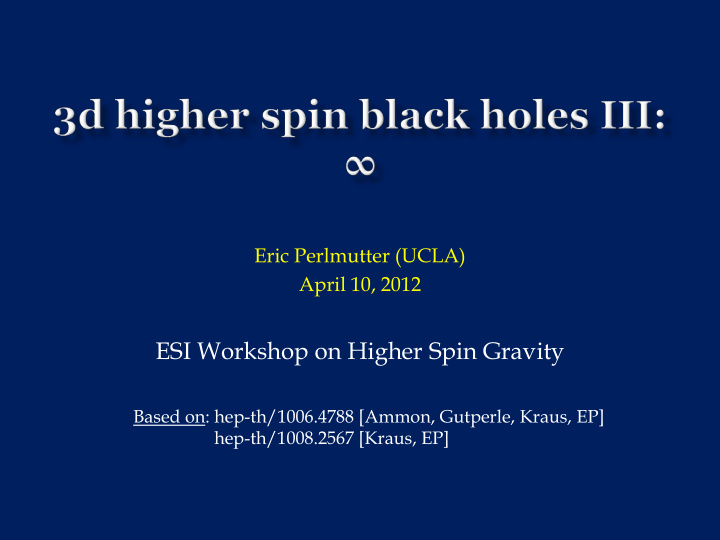



Eric Perlmutter (UCLA) April 10, 2012 ESI Workshop on Higher Spin Gravity Based on: hep-th/1006.4788 [Ammon, Gutperle, Kraus, EP] hep-th/1008.2567 [Kraus, EP]
(Part of) 3d Vasiliev gravity as a Chern-Simons theory 1. Introduction to hs[ λ ] and extended chiral symmetry, W ∞ [ λ ] 2. Making a hs[ λ ] black hole 3. AdS 3 /CFT 2 vector model duality 4. Comparison to free CFT with W ∞ [ λ ] symmetry Open questions 5.
Degrees of freedom: Metric (s=2), plus infinite tower of massless higher spin fields, s = 3,4,… # matter multiplets (e.g. scalar fields); masses fixed by symmetry Dynamics fixed by higher spin gauge invariance (~Diff + more) Variables: Spacetime coordinates [Prokushkin, Vasiliev] Bosonic spinors A pair of Clifford algebras comprised of “ M aster field” content: Higher spin fields Realizes internal Matter fields higher spin symmetry
Higher spin “oscillator” algebra: with multiplication by Moyal (star) product; similarly for ν has many roles: Appears in higher spin algebra (“deformation parameter”) Parameterizes AdS vacua Fixes scalar mass Spin-s generator ~ e.g. SL(2) subalgebra: Expand master fields in oscillators, e.g.
Master field equations satisfied for: Simplest solution is AdS: But any flat W will do higher spin backgrounds Re-write W in terms of gauge fields: Then
What is the Lie algebra? Define generators: e.g. The {V} generate the higher spin algebra hs[ λ ], where Conclusion: the gauge sector of Vasiliev theory can be written as two copies of hs[ λ ] Chern-Simons theory. e.g. AdS now looks like simply generalizing SL(2) construction.
3D 4D Gauge higher spin d.o.f. All d.o.f. propagate One pair of oscillators Two pairs of oscillators Deformed oscillator algebra Only undeformed oscillators Arbitrary numbers of scalars Cannot add matter multiplets N(spins) = finite or infinite N(spins) = infinite Field equations fixed Scalar self-interaction ambiguity Easier? Harder?
[Pope, Romans, Shen] Commutation relations Structure constants are known At λ =N, an ideal forms: recover SL(N) Exactly one SL(2) subalgebra; no other SL(N) subalgebras for generic λ Low spin examples: Underlying associative “lone star product”: Identity is
SL(N) hs[ λ ] SL(2) Virasoro (W 2 ) W N W ∞ [ λ ] Generalized Brown-Henneaux boundary conditions give In reverse: bulk Lie algebras are “wedge subalgebras ” of boundary extended conformal algebras conformal algebras (vacuum invariance) [Campoleoni, Fredenhagen, Pfenninger, Theisen; Gaberdiel, Hartman; Henneaux, Rey]
W ∞ [ λ ] is highly nonlinear algebra; structure constants now known in closed form [Campoleoni, Fredenhagen, Currents J s , with mode expansions Pfenninger] Schematically, In a Virasoro primary basis, nonlinearity increases with spin. To recover hs[ λ ]: Restrict to wedge modes, |n|<s: eliminates central terms 1. Take large c: eliminates nonlinear terms 2. Analogous to SL(2) embedding in Virasoro:
The gauge sector of 3d Vasiliev theory is (two copies of) a hs[ λ ] Chern-Simons theory. The asymptotic symmetry algebra of AdS hs[ λ ] gravity is W ∞ [ λ ] CFTs with W ∞ [ λ ] symmetry live on the boundary of AdS. Goal: to write down a black hole solution of hs[ λ ] gravity with nonzero higher spin charges, and compute its partition function. A Cardy formula for higher spin black holes Later, we will “count” the entropy microscopically in a simple theory with W ∞ [ λ ] symmetry: free bosons
Recall the SL(3) black hole connection with spin-3 chemical potential, μ : Manifestly a flat connection: Suggests general method for constructing higher spin black hole connections with spin-s potential, μ s , in any bulk CS theory with SL(2) subalgebra: Metric will look like black hole (e.g. have a horizon) in some gauge… but is it smooth?
Enforce BTZ holonomy constraint. This determines which charges you need, and their functional dependence on { τ , μ s }. With , solve An Algorithm Deform BTZ solution by adding chemical potential(s), { μ s }, and some 1. number of higher spin charges while maintaining flatness. Determine charges as a function of { τ , μ s } by enforcing the BTZ holonomy 2. constraint: the black hole will now be smooth.
Simplest case: turn on spin-3 chemical potential Step 1: Write down the solution: where and Black hole is a saddle point contribution to the CFT partition function As in SL(3), take
Novel infinities: N(holonomy equations) N(higher spin charges): Non-perturbative curvature: in wormhole gauge, AdS (IR) AdS (IR) AdS (UV) SL(N): hs[ λ ]: g +- ~ e - ∞ ρ g +- ~e -4 ρ g +- ~e 4 ρ
Step 2: Solve holonomy equations: Work perturbatively in α : Solution through O( α 8 ): Entropy and integrable charges follow by differentiation, all charges also fixed
Higher spin, but no scalar, “hair” Reproduces SL(3) result at λ =3 Compare to partition function of U(1)-charged BTZ black hole: [Kraus, Larsen] Grand canonical partition function of W ∞ [ λ ] CFT deformed by spin-3 chemical potential Holography: Reproduce this from CFT? At T ∞, modular transformation maps to vacuum OPE structure. [Gaberdiel, Hartman, Jin] What CFTs have W ∞ [ λ ] symmetry? W N minimal models in ‘t Hooft limit * (*we think)
Consider coset model [Gaberdiel, Gopakumar] Take ‘t Hooft limit: Central charge scales like N Dual to 3d Vasiliev gravity with pair of complex scalars: Coset believed to have W ∞ [ λ ] symmetry in ‘t Hooft limit Substantial evidence: Partition functions [Gaberdiel, Gopakumar, Hartman, Raju] W ∞ [ λ ] symmetry [Ahn] 3-pt correlators [Chang, Yin; Ammon, Kraus, EP]
A simpler realization of W ∞ [1]: free, complex, singlet bosons [Bakas, Kiritsis] Compute Z non-perturbatively: where Perturbative expansion matches bulk result at λ =1 Note: zero radius of convergence
Interesting effects from multiple potentials Scalar in hs[ λ ] black hole background [Ammon, Kraus, EP] Wave equation known, in principle, at given order in α Subleading contributions to Z Better understanding of holonomy-integrability relationship D=4 black holes
Recommend
More recommend